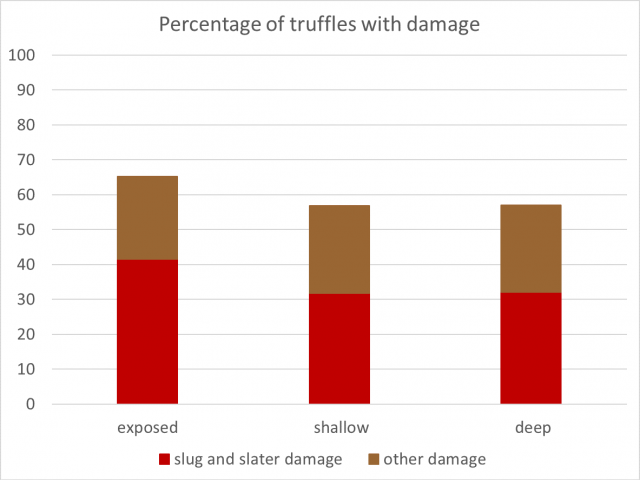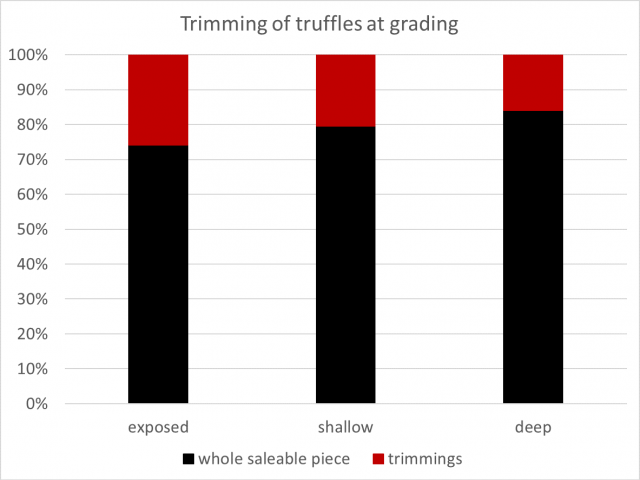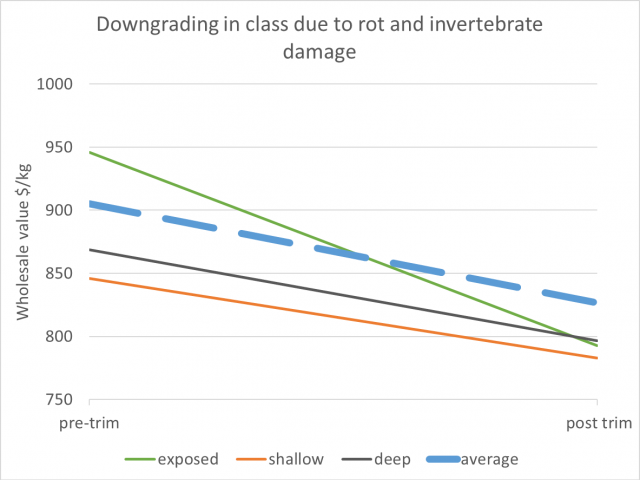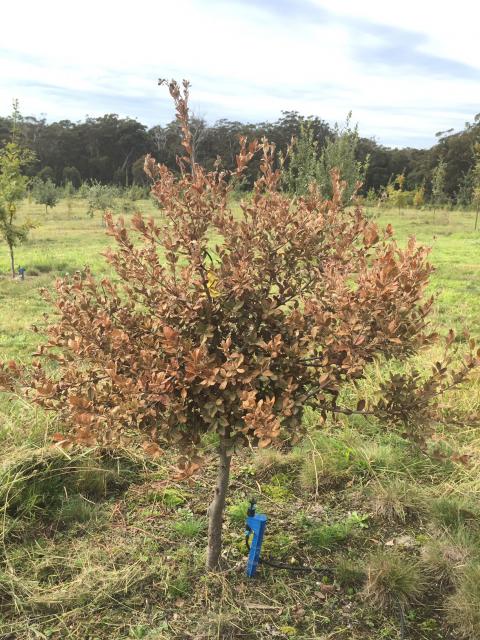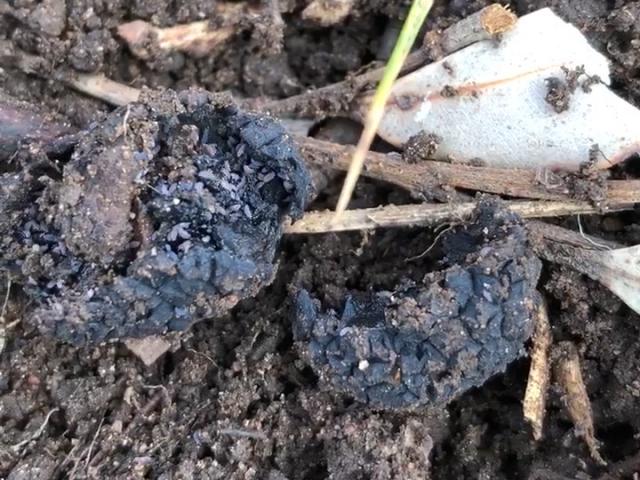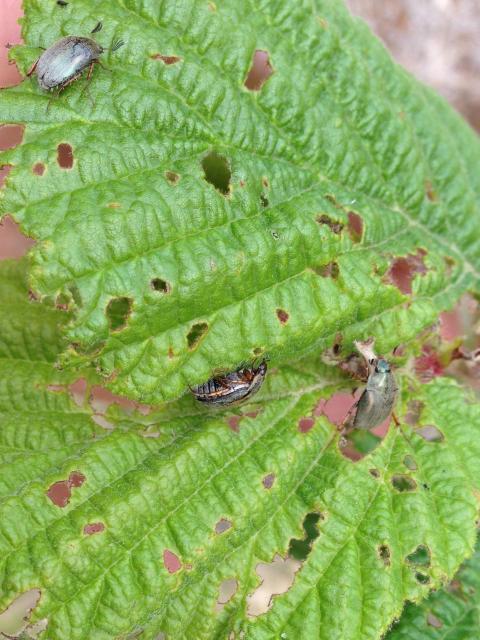The truffle pest and disease project winds up
Back in 2014, there was a necessity to build on our understanding of challenges faced by truffle growers to produce good yields of quality truffles. For a fledgling Australian industry like almost no other, there was limited knowledge of the pests and diseases that attack truffles and host trees let alone how to manage them.
A team of scientists and growers was assembled and an application made to the Rural Industries Research and Development Corporation (now AgriFutures Australia). We had encouragement and support from Dr John de Majnik, Senior Program Manager, Plant Industries at the time.
And so the project “Pests and diseases truffles and their host trees in Australia” began.
The project commenced during the 2015 truffle season and it gathered momentum as we came to grips with the task of rolling out an Australia wide project based in WA. Having good support from the committee of the Australian Truffle Growers’ Association as well as experienced team members based in Canberra and Orange made the tyranny of distance less an obstacle. The support of the newly formed Truffle Producers of Western Australia was also most helpful in getting things done in WA. The financial and logistical support of both grower associations streamlined the execution of the project tremendously.
We have travelled literally and figuratively a long way since July 2015. The plan for the project was based around:
- communicating results to truffle growers by:
- inviting growers to participate in a baseline survey
- setting up a web page to communicate results via articles, six-monthly newsletters, field days and talks at the national conference
- introducing MyPestGuide as a way for growers to request identification of pests and diseases
- undertaking regular monitoring in individual truffle orchards in all major growing regions to try to identify pests and diseases to understand their seasonality. We found undertaking regular studies in Tasmania a challenge and had to rely on occasional visits.
- investigating ways to monitor and manage the key pests.
Like any study of biological systems and especially one where the end product is a soil borne fungus growing in association with roots of host trees, there is still much to be learnt. However, the project team has made some major strides. Some of our results were expected but there were a few surprises:
- We thought that slugs were going to be an important pest and were not disappointed. All six species (one remains unidentified) we found were involved with damage to truffles.
- That slaters can damage truffles was a big surprise and probably is the biggest single pest complex that damages truffles across Australia.
- While native truffles occur in Australia, we were surprised to identify a native species of beetle that was a direct pest of truffles. High levels of damage were restricted to one orchard, but the potential is there for other orchards to be affected. This beetle probably represents the biggest single threat to the Australian truffle industry, a threat that will only be clear with the passage of time.
- A range of species of millipedes will feed on truffles but we are yet to have a good understanding of their role as pests because none of the orchards that we were involved with were heavily infested by them.
- Springtails were considered a primary pest in some orchards. Their pest status and management requires further study
- A good record of tree diseases across Australia was produced and for the more important ones, their pest status was qualified.
- We extended our knowledge on truffle rots and developed an assessment method for understanding the impact of rots and other damage. There is scope for further research in this area.
Obviously there is much still to do to come to grips with the various aspects of orchard management that will improve the health of truffle trees and reduce the damage caused by pests and disease of both the host trees and the truffles they grow symbiotically with.
By far the most useful outcome of the project is the clarification of the identity of pests and diseases of the host trees and truffles and to some extent their pest status. We feel this will give growers the confidence to monitor in their own orchards and make decisions to minimise any damage they cause.
We take this opportunity to thank both the greater team involved in the truffle industry for their support and encouragement to undertake this project:
- Australian truffle growers for their interaction and allowing us to tread through their orchards
- Funding and logistical support from AgriFutrures Australia, Department of Primary Industries and Regional Development (WA), ATGA, TPWA, Australian National University, Advyron, Manjimup Underground, Department of Primary Industries NSW and Truffle and Wine Co. Manjimup.
And the greater RD&E team:
Gavin Booth, Helen Collie, Peter dal Santo, Alan Davey, Wally Edwards, Harry Eslick, Duncan Farquhar, Diana Fisher, Alan Jacob, Celeste Linde, Michael Lowe, Alison Mathews, Anne Mitchell, Janet Paterson, Ainsley Seago, Alf Slater, Peter Stahle, Paul Webb.
2018 Harvest damage assessment
We’ve been working with a number of truffle orchardists over the last two seasons to assess the level of damage at harvest. The data is being examined to determine the relationship between depth at which truffle grow and damage, confirm the relationship between the level of damage seen at harvest and the number of pests, particularly slaters and slugs, from monitoring earlier in the season and estimate the economic cost of invertebrate damage as well as rot.
This year we visited six orchards three times each over the course of the harvest season. There were also some other orchards visited on one-off occasions.
Each time we visited, we collected 50 random truffles, which were sorted into:
- Exposed - breaching the surface,
- Shallow - top of truffle within 25mm of soil surface and
- Deep - top of truffle more than 25mm below the soil surface.
These truffles were washed and assessed for damage, then trimmed and graded by industry professionals to the industry standards. When assessing damage, where possible we attributed it to a particular pest or groups of pests. This is not always easy to do as many pests are no longer present in the truffles by the time they are harvested and the damage they cause is the same or similar. If you’d like to know more about assessing harvested truffles see out page on Assessing invertebrate damage to truffles at harvest and grading.
What we found
We saw the trend of more damage in exposed truffles as was the case last season. The chart below combines data from all orchards visited. It has the percentage of truffles with damage on the vertical axis for the three different depths. The red section of each bar is the percentage of damage attributed to slugs and slaters. The brown section is damage attributed to rot and all other invertebrates. As you can see across all orchards that we assessed this harvest slugs and slaters were responsible for almost two thirds of the damage in exposed truffles and over half of the damage in deeper truffles.
When you look at rot alone there is the same trend of less damage with depth, as seen in the chart below. This data includes fully rotten truffles found during harvest as well as those with patches of rot that could be trimmed out.
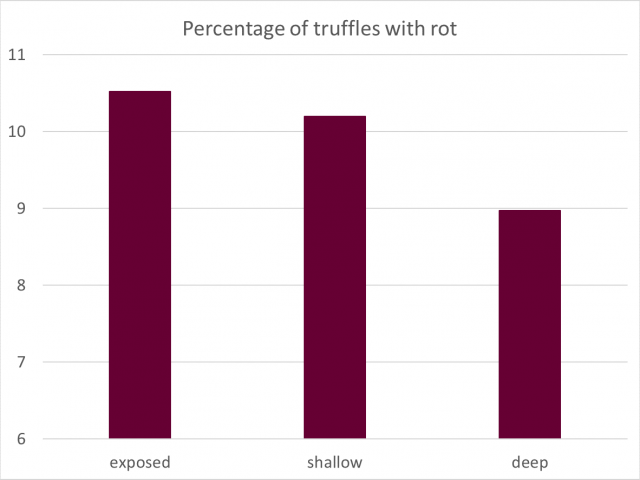
The graphs above were averages of all properties. The following two graphs breakdown the results for the individual orchards that we visited at least three times this season. The properties are labelled A through to G; exposed truffles are the green bars, shallow are orange, grey are deep and blue is the average of all depths.
The next chart show the percentage of truffles with damage attributed to slugs and slaters. In almost all cases the exposed truffles had the highest percentage of damaged truffles. Very few slugs and slaters were found on properties A and E as part of our monitoring and they also had low levels of damage attributed to these pests. Property G had one of the highest slater numbers of monitored orchards. As you can see 100% of the exposed truffles in property G had some level of slug and slater damage.
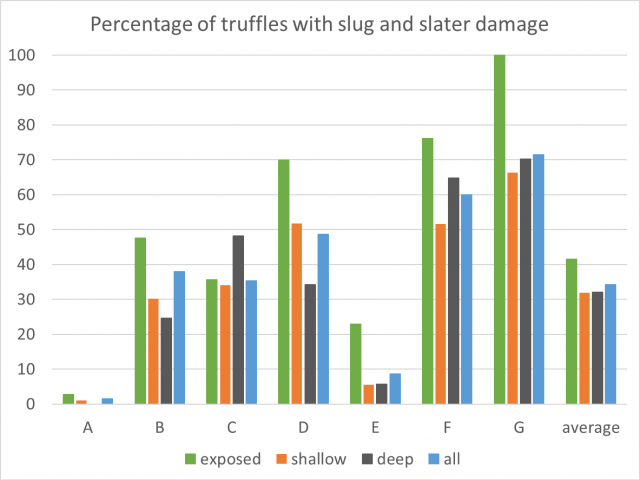
The next chart shows the same properties, this time with the average level of loss per truffle due to slug and slater damage. Again, the exposed truffles are hardest hit. Looking closer at property G not only did 100% of exposed truffle have some sort of slug or slater damage but on average 30% of each exposed truffle was eaten.
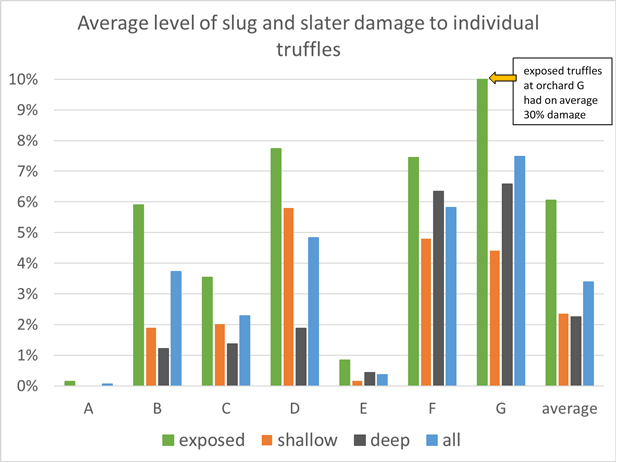
There is a large amount of variability across orchards in the amount of damage seen at harvest. But if we just look at the average across all orchards (the last grouping of columns on the chart above) the high level of damage in the exposed truffles compared to deeper ones is very obvious. This shows that on average 6% of every single exposed truffle we harvested this season had been eaten by slugs or slaters.
We don’t think slugs and slaters actively seek out truffles. They are wandering the orchard floor and if they come across something tasty they stop and eat. They are much more likely to come across an exposed truffle, or a shallow truffle that has become exposed due to soil cracking. This has implication for your management, in terms of encouraging truffles to form at some depth and covering exposed ones.
In one of the other articles in this issue we write about springtails, highlighting the damage they can cause after seeing it in an orchard this season. Property A was the property suffering from springtail damage. If you look back to the charts above you can see that there was almost no damage attributed to slugs and slaters and very few were found using tile and pitfall monitoring. But that’s not to say they had no damage. The chart below breaks down what was causing damage in the exposed, shallow and deep truffles at property A. They had a bit of rot but the vast majority of damage was attributed to springtails.
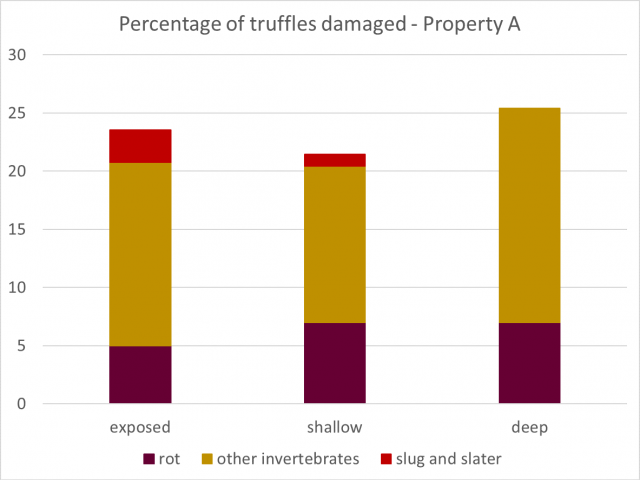
This highlights why it is important to monitor for pests while your crop is growing, and also to observe and takes notes during harvest and grading to determine what is present in your orchard and what is causing damage. Every orchard is different.
Grading
It should come as no surprise that with the higher level of damage to exposed truffles more of these truffles was trimmed during grading – see, the chart below where the amount of truffle that required removal due to rot or damage is shown in red. The red portion that goes to trim, peel, industrial grade or trash are much lower value than whole pieces.
As part of our assessment we assigned a grade to each truffle prior to trimming, ignoring the damage by invertebrates. So taking into account shape, size, colour, aroma, what grade would that truffle have been if it hadn’t been chewed on. After trimming each truffle was graded again. This gave us an idea of the amount of downgrading due to invertebrates.
This data was combined with some season average wholesale values for the different grades and is shown in the chart below, with pre trim values on the left and post trim values on the right. The green line is the average for exposed truffles across the six properties for the whole season, the orange line is shallow truffles, and the grey line is deep truffles. The blue dashed line is the average across the season for all properties and depths of truffles. This shows that on average invertebrate damage led to the value dropping from over $900/kg to $825/kg, that is 5% loss just from damage resulting in a lower grade of truffle. On average, there was a bigger drop in potential value of truffles in those that were exposed, reflecting the higher level of damage seen in exposed truffles.
In summary the main messages from the harvest assessments are:
- Slugs and slaters are widespread and when abundant can cause significant damage.
- Exposed truffles are more likely to be damaged by invertebrates and rot.
- Every orchard is different, get to know your pests.
- Invertebrates are likely chewing into your bottom line.
We would like to take this opportunity to thank the growers that allowed us to undertake harvest assessments with them. We understand that harvest is a very busy time of year and having an extra body or two around can add to an already hectic schedule. Without their help, work like this would not be possible, thank you.
Fungi important in disease on hazelnut trees
While visiting orchards as part of this project we observed that many have trees that are looking unhealthy and show disease symptoms, or have died. The number of unhealthy looking trees varies between orchards, from very few to a high percentage of trees. Unhealthy trees typically showed twig and branch dieback, distorted or under-developed leaves, or poor development compared to the general orchard. Some of the “unhealthy” symptoms are due to genetic variability in the seed source used to establish the trees, these trees typically display as “runts”. However, many of the symptoms we see are likely produced by pathogenic fungi. The purpose of this study was, therefore, to identify the fungi that cause disease.
A number of potential fungal pathogens were isolated from diseased or unhealthy looking oak and hazel truffle inoculated trees planted in orchards in Australia. Some of these fungi are well-known plant pathogens, such as Neofusicoccum, also known as Botryosphaeria, and Phytophthora cinnamomi. Neofusicoccum causes a dieback, called Botryosphaeria dieback, in a variety of plant species and Phytophthora root and collar rot is a serious disease causing mortality, especially under waterlogged conditions. A number of fungal species were also isolated which are not known as pathogens in oaks or hazels. This is partly because traditionally oaks (Quercus ilex and Q. robur) are understudied for their pathogens as they are not commercially cultivated, other than for truffle production. However, these fungi are known as pathogens in other tree species and therefore, warranted testing on truffle hosts.
To test the pathogenicity of these fungal species, an inoculation trial was established on 15-year-old Corylus avellana (hazel) trees. A trial on oaks is underway but unfortunately results are not available yet. The inoculation process involves growing the fungi on agar in the laboratory, then inserting an agar disc of each fungal species into a hazel branch. This is replicated over at least 10 trees for each fungus. A control treatment was included, where only agar but no fungus was inoculated. If the tested fungus is a pathogen, a lesion will develop on the branch. The more aggressive the pathogen, the larger the lesion. After two months, the length of the lesion produced is measured. Figure 1 shows the results of the inoculation trial in graphic form.
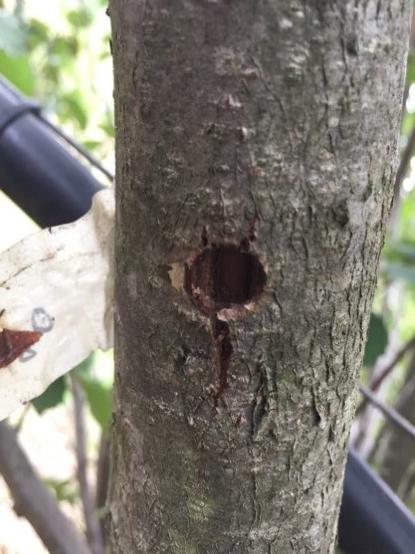
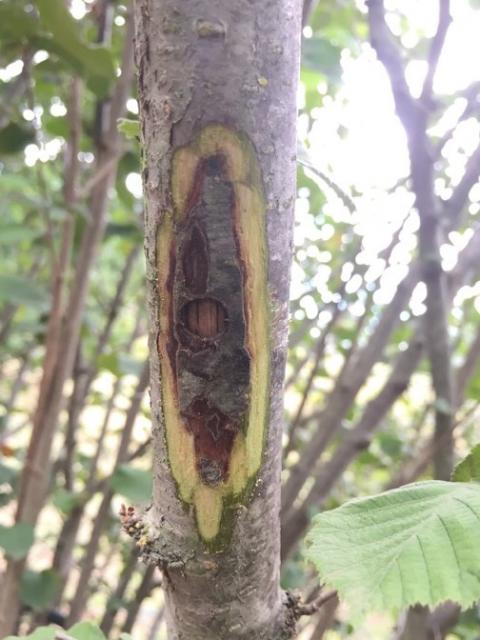
Not surprisingly, Neofusicoccum and Phytophthora caused the biggest lesions, confirming their role as pathogens. A number of other fungal species also caused significant lesions. These fungi include Diaporthe species, Illyonectria, Paraconiothyrium and Fusarium.
Diaporthe is interesting as it may also be found in healthy trees. This suggests it is endophytic, meaning it can live within the plant without causing disease symptoms, but it may associate with stem cankers. This means that it falls into a class of pathogens that are very difficult to control, as it may form part of the tree’s microbiome, but only causes disease when the tree is under stress. Stress can be caused by a number of factors such as over- or under-watering, chemical damage/burn or physical damage e.g. from pruning, hail and/or wind. Recent observations suggest that other pathogens may also provide the necessary stress factor required for some endophytic fungi to cause disease. Other such pathogens in truffle orchards may include powdery mildew in heavily infected orchards.
Illyonectria is an important pathogen on nursery tree seedlings and warrants further investigation into its role in truffle host tree disease, given that it produced relatively large lesions in the inoculation trial.
Fusarium oxysporum was isolated from a waterlogged, wilting Q. robur. It is therefore not particularly surprising that it did not cause disease in healthy hazel trees. Further testing on Q. robur will shed more light on this potential pathogen as it falls into a class of very important, but host specific wilt pathogens causing devastating diseases such as panama wilt disease of banana.
In conclusion, the disease situation in truffle orchards in most cases is relatively benign, with only some trees showing disease symptoms or death. In orchards with extensive disease presence, there are usually stress factors that induce tree decline by endophytic fungi. Growers are encouraged to monitor any tree disease in their orchard and take steps to minimise tree stress.
Integrated Pest and Disease Management
Integrated Pest and Disease Management (IPDM) is a strategy that takes in account the whole crop ecosystem. Pest management decisions are based on economic thresholds using one or several of all appropriate pest management tools available while minimising the hazard to people and the environment.
IPDM is not one simple control measure but rather a process. The details of the process varies from crop to crop and region to region. The key aspects to any IPDM program are as follows.
Understand – Learn about what pests, beneficials and neutrals may be in the crop in order to be able to identify them. Gain an understanding of the interactions between them and their lifecycles in order to make informed management decisions.
Prevent – Control practices can be put in place to exclude or discourage pests from becoming established in the crop.
Monitor – Find out what is in the crop, where in the crop it is, at what time of year they are present and how many there are.
Action Thresholds – Every pest in every crop situation will have a threshold below which control is not economically viable i.e. the cost of damage by the pest is lower than the cost of control. Thresholds also varies with individual and their own level of comfort with pest risk.
Control – When monitoring and action thresholds suggest management is needed choose a management technique that is least disruptive to other agents in the orchard system and has least impact on the environment. Control options can fall into one of the following categories.
- Biological – this includes predators, parasites, pathogens and competitors that will kill or disadvantage the pest. They are often referred to as beneficials.
- Cultural – this includes crop management practices such as weeding, pruning and irrigation control that reduce pest reproduction, dispersal and survival. There are also pre-plant cultural practices site as site selection and ground preparation that can help manage pests and diseases.
- Mechanical/physical – these are controls that physically kill or exclude a pest and include things such as tillage, traps and plant guards.
- Chemical – In IPM, chemical pesticides are not excluded but should be used selectively to have minimal impact on non-target organisms, the environment and people. They are often used in combination with other management options and in a targeted way. Note that there are currently no pesticides registered or permitted for use in truffle orchards in Australia
Evaluate – After taking action, assess and evaluate its effectiveness. Continued monitoring is often part of this.
How can this be applied in truffle orchards?
One of the keys of any integrated pest management program is monitoring. We’ve created a guide on orchard monitoring for the most commonly found invertebrates, including slugs and slaters. The guide provides instructions on how to monitor using tiles and bran, example recording sheets that you can print off, as well as a printable colour field guide to the more common pests and beneficials found in truffle orchards.
This type of field monitoring can be conducted year round, because it is not just when the truffle are ripe that they are being eaten. It is useful to monitor regularly because pest numbers fluctuate. With regular monitoring and observations you can build up a really good picture of what pests are present and how abundant they are.
Whole of orchard monitoring also helps identify hotspots, which allows you to target your management to where it is needed.
There are also guides available with colour photos for recognising invertebrate pest damage at harvest and grading. Taking and recording data such as the percentage of damaged truffles, the type of damage or the amount of trim is a very useful tool to make comparisons across blocks and across seasons. And the monitoring and harvest observations also allow you to see the impact of any management you’ve done. Any management you do must be value for money to make it worthwhile, so it important to know if it really did reduce the number of pests and reduce the level of damage.
We are in the early stages of determining the best practices in pest prevention and control for truffle orchards but some strategies are:
- If African black beetle (ABB) are known to cause damage to establishing trees in your region, one approach is when planting trees ensure there are no ABB in the planting hole and then sink the tree guard 5cm into the ground to prevent access to the plant by adults.
- Reduce undue stress on trees to improve their resistance to disease, this includes timing an rate of irrigation.
- Physically excluded free water and insects that cause rot and feeding damage by covering exposed truffles.
- If slugs, slaters and/or millipedes are a problem reduce habitat favourability and food sources in the orchard by removing leaf litter and maintaining a clean orchard floor.
- Because slaters are attracted to light, a light combined with a pitfall trap buried in the soil may provide some control. Such light traps have not been trialled on an orchard scale.
Next year an IPDM guide for truffle growers will become available, combining the information from current web publications produced by the truffle pest and disease project (list current web pages). Keep an eye out on the DPIRD website for this.
Disease or drought?
There are quite a number of plant diseases that directly affect conductive tissue within plants. The aerial symptoms are often hard to distinguish from drought. While this means such diseases may go undetected at times of drought, the presence of drought-like symptoms at times when soil moisture is at a reasonable level, is a great indicator that something is going on that needs investigation.
These diseases may be fungal like Phytophthora cinnamomi, a fungal-like organism that is widespread in Australia and is responsible for Jarrah Dieback in Western Australia, or bacterial, like Xylella fastidiosa** – not yet found in Australia. They work in the same way by causing the tap between the roots and leaves to be turned down, or off. As a result, plants can develop wilt and dieback symptoms, which, as mentioned above, can also be seen in plants experiencing drought.
Be vigilant and get help ASAP:-
If your orchard has symptoms like this that you can’t explain, speed is of the essence. The earlier you get help to identify the cause of a problem like this, the greater the chance you have of stopping it while minimising your losses. Waiting and watching in silence, may be condemning your orchard, and maybe others around you, to maximum loss.
The Australian truffle industry is very fortunate to have access to the expertise of Associate Prof Celeste Linde, who has worked with the industry on tree diseases, tree certification and truffle identification for several years. Celeste can be reached by emailing celeste.linde@anu.edu.au .
**Xylella fastidiosa is one of the most significant emerging plant disease threats worldwide. Although it has not been found in Australia as yet, it has been officially identified as Australia’s top National Priority Plant Pest because of its potential to severely impact Australia’s plant industries and environment. A draft “National Xylella fastidiosa Action Plan” has just been released by Plant Health Australia to stakeholder groups for comment by 14 December 2018.
Springtails in Truffle orchards
We have found springtails in many orchards where we have monitored for pests. It is also not uncommon to find them in truffles during harvest; however such truffles are usually already damaged or rotten. In these cases, they are regarded as secondary feeders. However, this past season we have observed springtails as primary feeders causing reasonable levels of damage as well as being a risk of remaining in graded truffle ready for market.
It is worthwhile familiarising yourself with their appearance and the damage they may cause to truffles as an aid to monitor for them in your orchard or in truffles when grading.
Springtails, Family Collembola, vary in size and colour. There are thousands of species of collembolan worldwide. Those that we’ve seen in truffle orchards range from 1-3mm long and are white, grey/purple, grey, brown and through to black. Because of their size, they can be easily missed during monitoring, particularly when you are not specifically looking for them or they are in low numbers.
They are wingless and possess a tail-like appendage, a furcula, which is normally tucked under the abdomen and when that flicks out they jump, hence the name springtail. This distinctive movement is the easiest way to identify them, they hop around, particularly when disturbed. If you are doing tile monitoring in your orchard it is worthwhile giving the tile a tap after you have turned it over. What could easily be mistaken for dirt or other debris may be springtails and after you tap the tile you’ll see them move.
The usual sources of food for springtails include algae, fungi and like almost all of the other main truffle pests, decaying vegetable matter. They prefer damp, moist or humid conditions high in organic matter or decaying vegetation, which applies to a wide variety of terrestrial ecosystems. In most circumstances springtails are thought to be beneficial and a good indicator of a healthy ecosystem.
The primary damage caused by springtails that we have observed looks like tiny pinholes, much smaller than those caused by truffle beetles and other invertebrates. The damage is generally clustered and reasonably shallow. They do tend to hide out in cracks and crevices of truffles, so you are more likely to find damage there.
At this stage there are no known management options specific for springtails in truffle orchards. Orchard operations undertaken to make the truffle orchard environment less suitable to the most important truffle pests, slugs and slaters, may also make it a less hospitable environment for springtails and hence reduce their abundance. These measures include pruning to increase light levels, desuckering hazelnut trees, avoiding over-irrigation, removing prunings and leaves from the orchard floor and encouraging truffles to form below the soil surface.
Spring beetles in truffle orchards
This spring we received a number of enquiries from truffle growers in Western Australia concerned about leaf feeding caused by spring beetle. These beetles are a native insect that occur mainly in Western Australia. As the name suggests spring beetles occur most often during spring. By the time you read this article in December, they will most likely have disappeared but may well return again next spring.
Spring beetles have a wide host range and apart from a range of native plants, they attack commercial crops such as deciduous fruit tree crops and avocados, and many ornamental plants such as roses. On apples they feed on leaves, petals and very occasionally fruitlets. They do not appear to feed on the growing tip of plants so unless plants being attacked have little foliage such as newly planted trees, the beetle is unlikely to be important. In truffle orchards, they usually feed on hazelnut trees but also French oak (Quercus Ilex).
The insect looks concerning because of their high level of activity during the day and very obvious feeding damage, however in most cases their feeding can be tolerated. They are not present in the orchard for long, most often leaving by late spring/early summer and healthy trees can tolerate feeding damage without any adverse long-term impacts. If you are concerned about their presence, keep an eye on numbers and level of damage, particularly if they are feeding on growing tips. We have not observed any damage to growing tips caused by spring beetle but they do have potential to do that and this could affect tree growth.
What happens in the orchard when you’re not there?
A time-lapse camera was set up in a truffle orchard, with a light designed to be activated after sunset, to observe invertebrate activity when we’re not looking, particularly at night.
The footage included here was taken in a section of orchard where there was minimal management undertaken for invertebrate pests so numbers are likely to be at the high end of the scale. In the footage you’ll notice an immature truffle breaching the surface, this was dug up from elsewhere in the orchard and placed within the camera field of view
The camera takes one frame every minute and you will see the date and time stamp along the bottom of each frame. The video moves quickly through the daylight hours when there is very little activity and slows for the overnight footage. There was a light set up with the camera that comes on at night so that we can still see what’s going on.
The main invertebrates you will see in the footage are slaters and beetles with the occasional Portuguese millipede. The footage was taken in March when truffles are immature; the feeding damage in the video is obvious from the white areas on the immature truffle.
This footage is not representative of what would be happening in a normal situation. We also exposed a piece of truffle in nearby part of the orchard away from the camera and light set-up. This piece of truffle did not have any feeding damage on it in the same period. The invertebrates are attracted to the light, intensifying their numbers and their potential to find the truffle to eat it. In a normal situation you won’t be getting the hordes of hungry invertebrates as seen here attacking one truffle placed on the orchard floor. Having said they if they are in your orchard they will still be wandering around at night but less likely to encounter truffles in situ.
Why worry about invertebrates?
So why do we need to worry about seeing something like this in a truffle orchard? It’s not just us that like to eat truffle, invertebrates like those in the video enjoy them too.
It’s not only the direct loss of product through feeding that is a concern and ultimately costing producers money. Invertebrates will feed on truffle when it is still immature and growing and keep on eating them throughout the summer and autumn into winter. The damage they cause is likely to leave the truffles more prone to rot, so instead of just a few chew marks that can be trimmed out that initial insect damage can potentially lead to the loss of a whole truffle. When it does remain as some isolated feeding on the truffle then that truffle is downgraded in class and depending on how much has to be trimmed the price received per gram can drop quite dramatically. Then of course there is the extra cost of extra time involved in the cleaning and grading of truffle with any imperfections. Even if you are doing this work yourself and not paying someone else, harvest is a busy time of year and time is money.
Get to know your orchard and what, if any, pests you have and whether they at high enough levels to be of concern.
Recent observations from WA disease survey
Project team member and plant pathologist Celeste Linde recently travelled to Western Australia to observe tree health and diseases in truffle orchards around the southwest.
It has been an exceptionally ‘good’ year for oak powdery mildew on Quercus robur (Figure 1). Multiple rain days in September and October provided the moisture needed for heavy powdery mildew infections. In the past we have advocated that powdery mildew infection is not of major concern for producing truffles, however such heavy infections were usually only evident at the end of the growing season or did not appear to significantly reduce the growth of the trees. The effect of these infections on truffle yield is unknown, but the early infections seen in 2018 could be detrimental to the health of the tree by providing avenues for other opportunistic fungi to infect. This in turn may severely reduce the photosynthetic ability of the trees (Figure 2) and cause more serious diseases such as diebacks. Any resulting tree death will obviously affect the truffle producing capacity of that orchard.
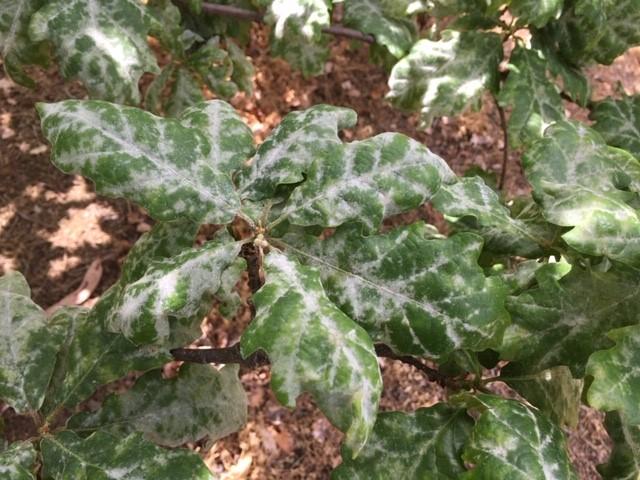
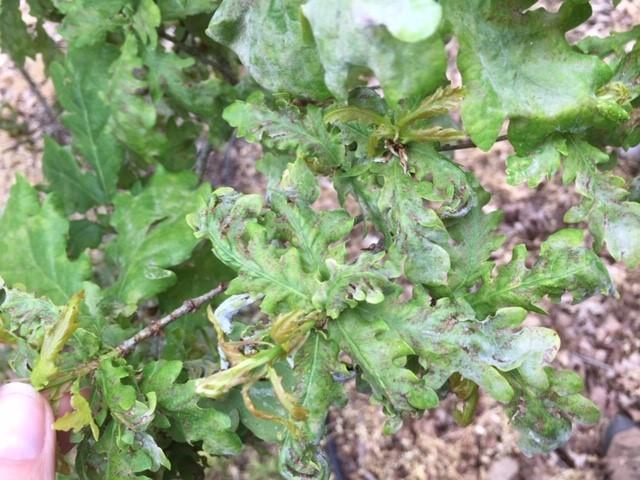
Traditional cultural practices to reduce powdery mildew infection includes providing adequate airflow in amongst trees. However, the ideal infection conditions of 2018 nullified this option as even orchards with adequate airflow showed heavy infections.
The observations this year raises the question of quality control in nursery seedlings. Within orchards, it is clear that there is a great degree of variation in the resistance of trees to infection with powdery mildew (Figure 3). Other horticultural and forestry industries have prioritised selection of seed stock for resistance to common or difficult to treat disease. This has not yet occurred in the Australian truffle industry. Inspecting a potential seed source for Q. robur in the south-west, it was quite evident that some trees are more resistant to infection than others are, with many seedlings showing powdery mildew infection, whilst others are relatively free of disease (Figure 4).
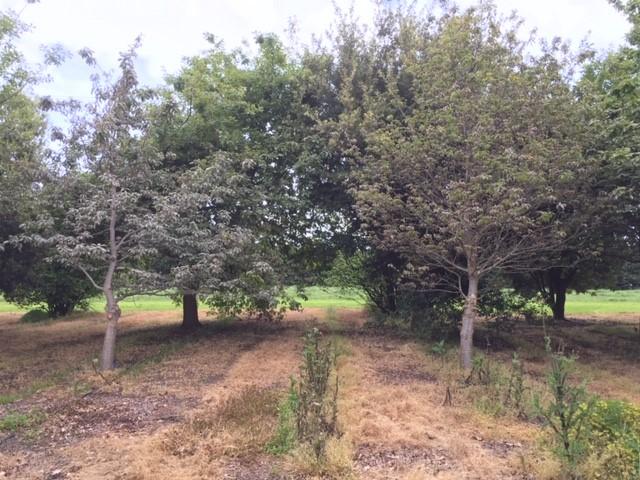
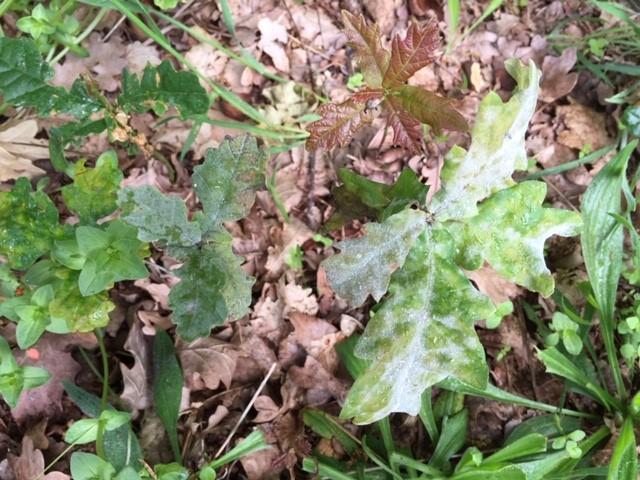
This is an area for further research in both oak and hazelnut species used as host trees for truffle production.
Eastern states’ road trip July 2018
To get an idea of where truffle growers are at as far as damage to truffles is concerned and take the opportunity to give an update on the project especially for those growers not intending to go to the September 2018 National Truffle Conference, Stewart spent two weeks in NSW, Victoria and Tasmania in July this year.
Truffle Damage
Where possible, Stewart tagged along as truffles were being harvested. The aims were to see if there were any new pests, which can only be identified confidently during harvest. The other main aim was to see whether damage was related to depth of truffles, as is the case for a study in WA where we found exposed and shallow truffles have more damage than truffles that form greater than 25mm. Stewart visited three orchards near Canberra, two in central NSW, two in Victoria and two in Tasmania.
The photos below indicate the activities undertaken and some of the main pests found.
Across the nine truffle orchards visited, damage by invertebrates as direct feeding loss by weight was less than 6%, but the proportion of truffles with any level of invertebrate damage varied from 26% to 59%. When such a high proportion of truffles is damaged at some level, a reasonable amount of time is spent in the grading room assessing and trimming truffles. As well as the reduced price due to downgrading there is also an extra cost of time to trim during this already busy part of the season.
In some of these orchards, limited bran-baited tile monitoring for invertebrates indicated their abundance was generally consistent with the levels of damage.
As far as identifying invertebrate pests that do not commonly damage truffles is concerned, the only possible culprit is millipedes. Unfortunately, this occurred in orchards where regular monitoring had not taken place, so this conclusion remains somewhat speculative.
As well as damage by invertebrates affecting yield, rot in truffles was recorded as significant in two orchards at 23 % and 33% loss. The cause for this was not apparent, especially given the dry season in the east during 2018.
Updates on the pest and disease project
Stewart gave a talk on the project activities at the following locations - Sutton, Bathurst, Ballarat and Deloraine. Anne Mitchell attended a truffle-grading workshop in Victoria in July where she also presented an update on the project.

